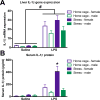Neuroinflammatory priming to stress is differentially regulated in male and female rats
- PMID: 29524458
- PMCID: PMC5953809
- DOI: 10.1016/j.bbi.2018.03.005
Neuroinflammatory priming to stress is differentially regulated in male and female rats
Abstract
Exposure to stressors can enhance neuroinflammatory responses, and both stress and neuroinflammation are predisposing factors in the development of psychiatric disorders. Females suffer disproportionately more from several psychiatric disorders, yet stress-induced changes in neuroinflammation have primarily been studied in males. Here we tested whether exposure to inescapable tail shock sensitizes or 'primes' neuroinflammatory responses in male and female rats. At 24 h post-stress, male and female rats exposed to a peripheral immune challenge enhanced neuroinflammatory responses and exacerbated anxiety- and depressive-like behaviors. These changes are likely glucocorticoid dependent, as administering exogenous CORT, caused a similar primed inflammatory response in the hippocampus of male and female rats. Further, stress disinhibited anti-inflammatory signaling mechanisms (such as CD200R) in the hippocampus of male and female rats. In males, microglia are considered the likely cellular source mediating neuroinflammatory priming; stress increased cytokine expression in ex vivo male microglia. Conversely, microglia isolated from stressed or CORT treated females did not exhibit elevated cytokine responses. Microglia isolated from both stressed male and female rats reduced phagocytic activity; however, suggesting that microglia from both sexes experience stress-induced functional impairments. Finally, an immune challenge following either stress or CORT in females, but not males, increased peripheral inflammation (serum IL-1β). These novel data suggest that although males and females both enhance stress-induced neuroinflammatory and behavioral responses to an immune challenge, this priming may occur through distinct, sex-specific mechanisms.
Keywords: Glucocorticoids; Microglia; Neuroimmune; Sex differences; Sickness behavior; Stressors.
Copyright © 2018 Elsevier Inc. All rights reserved.
Conflict of interest statement
Figures








Comment in
-
Stress-induced neuroimmune priming in males and females: Comparable but not identical.Brain Behav Immun. 2018 Oct;73:149-150. doi: 10.1016/j.bbi.2018.05.001. Epub 2018 May 10. Brain Behav Immun. 2018. PMID: 29753849 Free PMC article. No abstract available.
References
-
- Arakawa K, Arakawa H, Hueston CM, Deak T. Effects of the estrous cycle and ovarian hormones on central expression of interleukin-1 evoked by stress in female rats. Neuroendocrinology. 2014;100:162–177. - PubMed
-
- Biber K, Neumann H, Inoue K, Boddeke HW. Neuronal ‘On’ and ‘Off’ signals control microglia. Trends Neurosci. 2007;30:596–602. - PubMed
Publication types
MeSH terms
Substances
Grants and funding
LinkOut - more resources
Full Text Sources
Other Literature Sources
Medical

